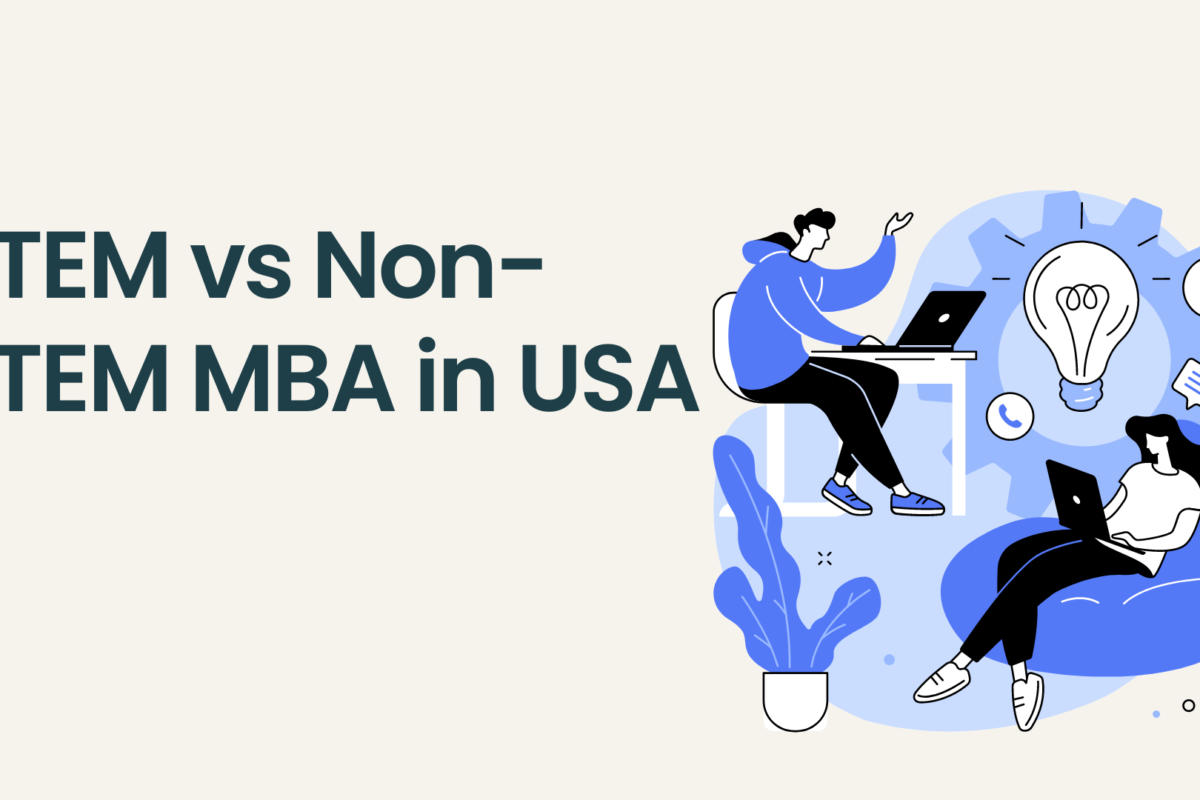Do you believe an MBA is worthwhile? If so, you already know that the United States offers the best MBA programs. Be it Columbia University, Harvard Business School, or any other university from a big league running first in this competition for the best MBA programs. It is excellent that you have already decided that you want to earn your MBA degree in the United States. You must now choose the type of MBA program you want to attend. However, obtaining a general MBA might not be sufficient for you. Apart from traditional MBA, another type of MBA program is available in the USA that integrates your technical background with the constantly changing business landscape. That is what this article is about- STEM MBA in USA.
Any MBA school will teach you how to run a business and give you management skills. An MBA is a professional degree that helps people become managers, innovators, or leaders in a certain area. There are STEM MBA programs and NON-STEM MBA programs in the US.
STEM MBA schools are made to help you get better at both business and technology. International students with a background in technology are becoming more and more interested in STEM MBA programs.
With both STEM and non-STEM MBA degrees, a person can improve their management skills by focusing on a certain area, such as finance, supply chain, sales, marketing, analytics, etc. There are, however, some differences between the two. Knowing about the differences will help you make the best decision.
Cost
Cost can sometimes be the biggest determinant of your choice of STEM or Non-stem MBA as an international student. The difference in cost between non-STEM and STEM MBA in US can depend on a number of things, such as the school, the length of the program, and the area.
STEM MBA programs can be costlier than traditional MBA as STEM programs require better resources, such as highly qualified teachers, more tech and analytics based curriculum, and advanced software packages. Also, these programs might be longer, two years is a standard period for STEM MBAs. This can also make the overall cost of tuition and other costs go up. On the other hand, Some non-STEM MBA programs may charge more than others because of their prestige or popularity.
Also, location is important while deciding which graduate program to apply for. For instance, the cost of an MBA program at a top business school in a big city and wealthy states can be much higher than the cost of a similar program at a smaller in a cheaper area. So, keep this in mind when trying to plan and finance your graduate degree. As an international student, money is the deciding factor while making decisions about grad school.
Value
One of the best things about a STEM MBA is that it can help you get a lot of different jobs in the STEM fields. STEM MBA graduates are well-suited for jobs like product managers, technology advisors, and data analysts, and they can often make more money than MBA graduates in other fields. Also, the specialized knowledge and skills that STEM MBA students learn can make them valuable assets to businesses in fields like technology, healthcare, and energy.
A non-STEM MBA, on the other hand, is a more traditional MBA school that focuses on business basics like finance, marketing, and management. Most of the time, these classes cover a wider range of topics and don’t just focus on STEM fields. MBA schools that aren’t in STEM are good for people who want to be general managers, business consultants, or financial analysts.
STEM MBA in USA offers 3 year OPT
You may be eligible for a visa extension through the Optional Practical Training (OPT) program if you have completed an MBA in a STEM field (Science, Technology, Engineering, or Mathematics). The OPT program permits F-1 visa students to work in the United States for a maximum of 12 months after graduation. You may be eligible for an additional 24 months of OPT extension, for a total of 36 months of work authorization in the United States, if you have completed an MBA in a STEM field.
Non-STEM MBA grads may still be eligible for the OPT program, but only for the usual 12-month extension. Visa criteria and eligibility can change, so always check with US Citizenship and Immigration Services (USCIS) for the most up-to-date information. Because STEM professions are regarded critical to the growth of the United States economy, the government enables non-citizen graduates of STEM-designated programs to work in the United States for an extended period without the requirement for a company-sponsored visa or an H1-B visa.
Unlike traditional MBA programs, STEM MBAs let international students stay in the United States longer after they finish. Even though all MBA graduates are qualified for 1-year OPT visas (unless they already got an OPT visa after getting a degree in the U.S.), STEM MBA graduates get a 2-year extension, giving them a total of 3 years.
Eligibility
Here are some important things to think about when applying for STEM MBA in USA:
- Bachelor’s degree: As an applicant, you must have a bachelor’s degree that is recognized by the government of your country. Your degree does not need to be in STEM area. But if you have a STEM degree, you may have a better chance of getting into STEM MBA schools.
- Work experience: STEM MBA programs usually ask for several years of professional experience and appreciate managerial and leadership roles in the eligibility criteria. Minimum two to three years of work experience is common in the applicants targeting STEM MBA. However, there might be some exceptions depending on the program you are interested in. In that case, start with emailing the director of graduate program (DGP) of that program.
- GMAT or GRE: Most people often dread this step. Even if you meet first two eligibility criteria, a good Graduate Management Admission Test (GMAT) or Graduate Record Examination (GRE) school might place you ahead in the admission process. The majority of MBA programs in STEM require GMAT or GRE scores as part of the application process. However, some institutions may waive this requirement if you already possess a graduate degree or extensive work experience.
- Letters of recommendation: You should give careful consideration to selecting your recommenders. This list may contain current or former supervisors, colleagues or peers, professors or academic advisors, as well as business or community leaders. Diversifying the recommendation sources allows the admissions committee to evaluate your strengths from multiple perspectives. In addition, I would suggest obtaining a letter of recommendation from your direct supervisor if you have a positive relationship with him. A recommendation from a superior is always preferable to a recommendation from a peer. However, this is my opinion, and yours may differ. In addition, make sure to inform recommenders about the STEM MBA program and the qualities and experiences that the program values. A recommendation letter should always be specific to the program you are applying to, not a generalized one.
- Essays or personal statements: As a candidate for a STEM MBA, you are required to submit one or more essays describing your background and eligibility, as well as how they relate to your application to the program. Writing graduate essay is my favorite part. However, it is difficult for some to come up with a compelling story. Try to comprehend the program you are applying to and read about its alumni as a good starting point. This will give you the keywords for your statement of purpose (SOPs). MIT Sloan school of management is known for its innovation, entrepreneurship and leadership whereas Jenkins MBA in North Carolina State University (NCSU) is more focused on supply chain background. So, be mindful when writing up your SOP for different schools. Do not focus on your childhood stories, which is a common mistake many candidates make. Rather focus on creating a clear and compelling story, a demonstration of fit with the program, a demonstration of leadership potential, a display of technical and analytical ability, to boost your chances of admission. It must also be well-written, interesting, and show a strong match with the curriculum. Spend time researching the program and learning about its unique qualities, and then use your essay to demonstrate why you are an excellent candidate.
- Interview: This is the final step in the MBA application process. Some STEM MBA programs require applicants to participate in an interview as part of their admissions procedure. This could be a one-on-one interview with an admissions committee member or a group interview with other applicants. Most schools offer interviews if you are short-listed, which is a good sign. So, if you’ve been invited to an interview, make the necessary preparations to ace it.
These are the fundamental criteria for a STEM MBA in the United States. Depending on the school, there may be more processes. So, before applying, do your homework. It is always preferable to prepare your entire admission package at once. It will be less stressful if you plan ahead of time rather than discovering you need more recommenders on the last day of application. Believe me, I’ve seen individuals struggle with this issue.
We have prepared a list of top B-schools, cost of programs and eligibility criteria. You can sign up to our exclusive newsletter and we will send you the list. If you have any questions or would want additional information on any of the topics discussed above, send us an email and we will help you.



